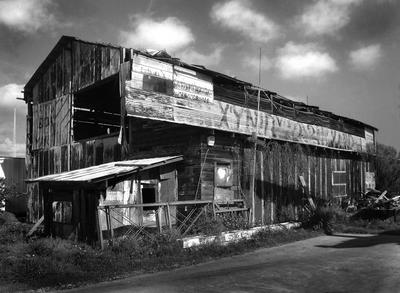
The Xynides Boat House. (Photo courtesy of Lowell Beyer)
Standing on top of a pile of broken timbers, exposed nails, torn electrical wiring, and a healthy dose of tetanus-in-the-wings can be a normal day for a maritime archaeologist. We recently had some of those days and I report on them here.
During the 1940s-1970s St. Augustine could have been called the shrimp boat capital of the world. It wouldn’t have been because of its home fleet of shrimpers but due to its thriving boatbuilding industry. All of this effort took place on the banks of the San Sebastian River, where St. Augustine’s modern maritime industry is still located. The Xynides family were key players in the building boom and from their yards came a steady stream of wooden shrimpers, cruiser trawlers and other types of custom wooden boats. The yard was owned by Harry Xynides and his son, Nick, still owns the place and operates it as a boat repair yard.
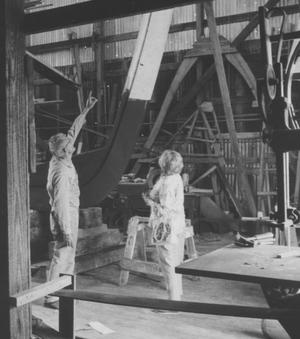
Harry Xynides looking at a new stem, note the upside down ‘V’ in the background. This was one of the molds we recovered.
Not long after 2005, when Chuck and Sam first started working at LAMP we began a relationship with the Xynides family that has recently grown into a working partnership. Nick Xynides, his sister Ellen DeMott and her son Justin DeMott have all been most gracious in sharing their history with us. Recognizing that one’s family history is a precious thing we feel that we are particularly fortunate to be able to help record and preserve a small part of it through pictures, stories, and tangible pieces of their maritime background.
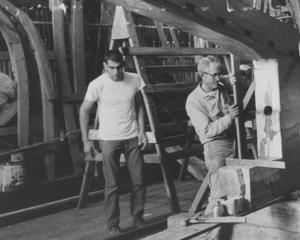
Nick and Harry Xynides working in the boat shed during the early 1960s.
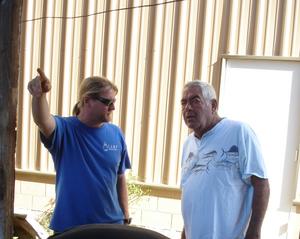
Chuck Meide and Nick Xynides discussing the moving of the molds.
When tropical storm Fay came slogging through St. Augustine late this summer she did a modest amount of damage on the waterfront. Aside from boats dragging anchor, some breaking loose, docks getting worked and losing planks the most catastrophic occurrence I believe to have taken place was the caving-in of the Xynides boat barn. The old building was a monument on the San Sebastian. Often photographed, much admired, it was one of the last historic structures on the riverfront and we mourn its passing. Nick and Ellen loaned us a collection of photos that provide a wonderful record of how the Xynides yard operated, who the people were, and shows some of the many boats they built. They also donated to the St. Augustine Lighthouse and Museum their collection of molds used to build boats. Boat molds are a set of timbers cut and assembled into a cross-section of a boat. Starting near the bow of the vessel, the molds are more ‘V’ shaped to take on the sharp angle of the cutwater and spread it to the wider beam of the boat as you move towards the stern. Imagine if you took out a set of the boat’s frames, or ribs, from each quarter of the boat, these would look just like the molds. When building a boat the keel, or spine, of the boat is laid along with the stem (upright forward-most timber in the ship) and the sternpost (aft-most upright timber in the boat). You now have a centerline from which to build the boat. To move from the boat’s plans to a real hull the blueprint lines must be transferred onto a lofting floor where they become 1:1 in scale. Then, molds are made to carry these lines into the shop.
Molds are made from multiple pieces of wood fastened together so they can be set on the keel (visit this blog entry to see molds in place during the initial construction of the Chaisson tender–fourth picture from the top) and a 3D image of the boat’s hull is formed. From this, the real frames of the boat can be fashioned to take on the shape of the hull and the angle of the planking. Once frames are laid and are all in place the planking may go on, forming the exterior of the hull. Boat molds are the master patterns from which future duplicates or similar hulls may be built. In the case of the Xynides boats, and with many other builders, they didn’t use a mold at each frame station (rib location). Instead, frames were spaced out at regular intervals so a boat 45’ long may involve 4 or 5 molds. To make a 60’ boat with a similar sweep of bow and transom the builder spaced the molds farther apart as needed to lengthen the hull.
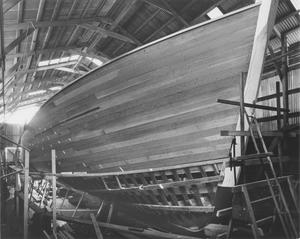
The hull being formed after molds have created the boat’s lines.
The Xynides molds were hung on the inside of the boat shed to store them between uses. Note in some of the old photographs you can see molds awaiting their next use. When we were told that we could have them, they were no longer in this condition. Age and the salt water environment had taken its toll on the old building and Fay helped to finish it off. A few molds were still hung/nailed to the remaining upright southern wall but some of the oldest molds had been crushed in the collapse. Nonetheless, we went in to help recover them and save what we could. Keep in mind that a boat barn houses an amazing array of things. Tools, timbers, lumber, fasteners, blocks and tackle all make up the list of regular suspects in this sort of setting but unless you’ve seen it I can’t begin to explain the sheer quantities of it all. Where a cabinetry shop may have a couple dozen chisels a boat building shop will have several dozen. Where a carpenter may keep ten or twenty pounds of nails lying around for projects a boatyard will have a whole room full of fasteners ranging from bolts three feet long down to tiny copper tacks. Scale takes on a whole new meaning in a boat barn. No longer will framing hammers do the job. Mauls, sledges and other huge pounding and cutting tools do the job here. Electric power tools also take on unusually large sizes. Two-man electric hand planers that would make an OSHA inspector weak at the knees are all a part of this heavy-duty business. The amazing thing though is how all of these brute instruments are combined with smaller precision instruments, large timbers and an exacting knowledge to make complex and beautiful machines. The people who made their living doing these things had little time to record how they went about their jobs and often, competition kept them from recording it out of fear of losing proprietary methods. The end result though, it something that even the most lubberly hack can marvel over and be swooned into admiration by.
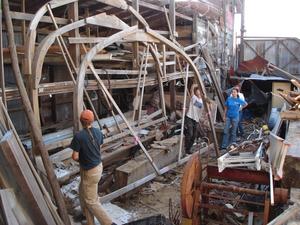
Moving the molds for dissasembly.
Part of recovering the molds involved clearing out the areas around them of the debris, fallen supplies, and tools in order to access them. A philosophy of ‘by whatever means necessary’ was employed with sheer muscle power being the most commonly called-on device. Nick, on his tractor could snake out heavy things using chain, rope, and pulleys to get around corners and angles. When we didn’t have the John Deere a block and tackle was rigged which I nicknamed my ‘Greek Tractor’. I got smiles from this instead of my block knocked off. Chainsaws, a sawzall, and pry bars were also used since we had to cut out some of the pinning timbers from around the molds and then disassemble them to get out of the building. Christine Mavrick, LAMP conservator, was on hand to label, organize the molds, and make sure they stayed in their respective bundles until Chuck drew a schematic of each one and photos were taken. Sam and I then fell to working apart the joints to get them moveable. Boat molds are made to be taken apart since once the vessel is built up around them you have to remove the molds for future projects. When the first load came out my truck was heaping full of St. Augustine history.
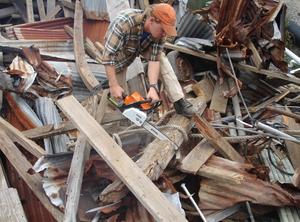
Chainsawing carefully to get at some trapped molds.
This first load was comprised of molds used in 1965 to build a 48” trawler cruiser. This boat, built similarly to shrimpers, was custom built for a client to would use the boat as a cruising pleasure craft. However, with the exception of rigging and some modifications to the hull methods used in building this boat were almost the same as that used in the construction of a shrimp boat. We were very happy to get these since they are some of the last remaining artifacts from a long history of building wooden boats in St. Augustine. Moreover, this was a building tradition that changed during the DESCO years and the boom of the 1970s. At the Xynides yard both Harry and Nick knew how to build the boat up from the ground, install the engine, build the wheelhouse, and do all of the final fitting and finishing. When their boats went into the water it was a fully Xynides product. DESCO and St. Augustine Trawler Company trained individuals on specific jobs. One man would be trained to install the engine, another to lay decking, one to rig the boat and so forth. No one person would be involved with the entire build. While more productive in terms of volume, the skill-set of one person was reduced to task labor and thus the industry became more industrialized. Soon after this the wooden craftsmanship would go the way of the dinosaur too. Iron and fiberglass replaced a material used since the first boats were built, a material often cited as having soul, emotion, and life.
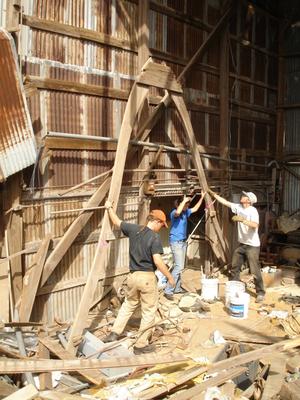
One of the older molds built and used by Harry Xynides. This one comes from the forward portion of the boat. Find this mold in the original black and white photos.
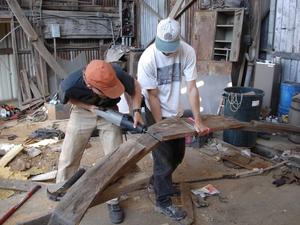
Disassembling the molds using a sawzall to cut the nails after we prized the timbers slightly apart.
The experience of retrieving the molds was educational and well worth the investment of time and effort. Personally, I learned much more about the history of St. Augustine’s working waterfront and it’s history than I ever would by studying in a library or researching in archives. It was a hands-on opportunity to meet the people who know and remember the waterfront as a place where St. Augustine relied on for its character and economy, who knew the water as a place of utility not pleasure, and a time to see the infrastructure of disappearing art.
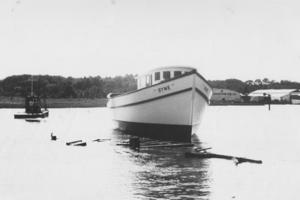
A freshly launched shrimper built by the Xynides. Symi is the name of the island in Greece from which the Xynides family hails.
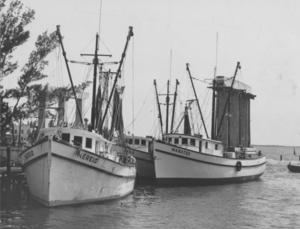
Two shrimpers built by the Xynides.
The Xynides pictures are currently being scanned into a digital archive to be part of the George R. Fisher Library here at LAMP and as soon as they are all in the system we will be working on making them more public so the community can enjoy them. The molds are undergoing treatment for insects and the ones that are broken will be reassembled to recover their lines. Stay tuned on this as I see a volunteer opportunity coming soon to make this happen! I want to thank the Xynides family personally and on behalf of the Lighthouse for their generosity. I also look forward to working more with Nick, Ellen and Justin to help keep alive their part of the story of our Nation’s Oldest Port.
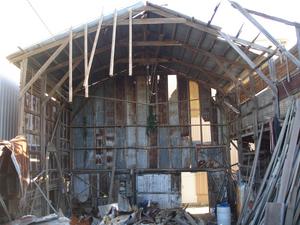
The Xynides barn after the collapse.
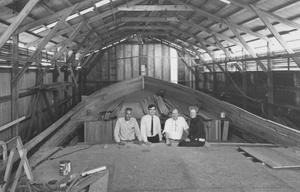
Boatbuilding was a family affair.
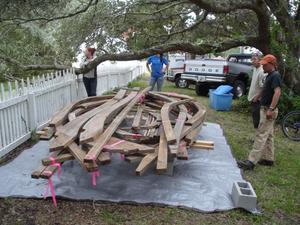
Organizing the molds once we got them to LAMP for pest treatment, wrapping in Visqueen for quarantine, and organization.
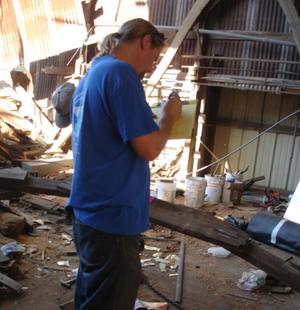
Chuck recording a mold before being moved.
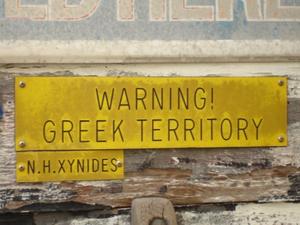
Beware Greeks bearing gifts!
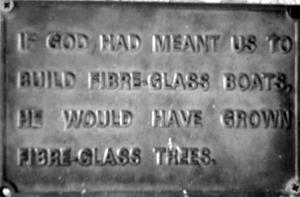
Some thoughts on wooden boatbuilding…

